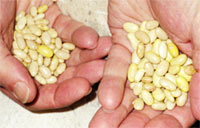No Ordinary Hill of Beans
Now suddenly this was no ordinary hill of beans, and a lot more than three people were fighting over it. Some were lawyers, some were farmers, and some represented an astonished Mexican government.
Ricardo Hernandez Muñoz, a commerce specialist in the international affairs division of Mexico's Department of Agriculture, says, "We got to the point where we [said], 'Well, I don't know where they got the idea that they can register something that's used all the way back to the Aztecs!' " Muñoz says, and then laughs.
"I thought, well, let's register hamburgers then. And let's charge a penny for every hamburger that an American eats. It's the same way. It's something that's part of the country. You cannot take it out just and say 'Hey I discover a yellow bean.' Sorry, my friend. That has exist[ed] for more than nations," Muñoz says.
Bean breeders in the United States and Latin America tend to agree. The Center for International Tropical Agriculture, in Cali, Colombia, is challenging Proctor's patent. The action is pending before the U.S. Patent and Trademark Office. CIAT holds 260 kinds of yellow beans in its public seed collection. It has done DNA analysis comparing six of those yellow varieties to Proctor's beans.
The findings, according to center director Joachim Voss: "We're comparing the genetic fingerprint of the Enola beans with the most likely candidates in our gene bank, and what we've found preliminarily is that we have an identical print with another of other varieties that we have in our gene bank."
Plant geneticists say there wasn't enough time between when Mr. Proctor first bought the beans in Mexico—1994, according to his patent application—and when he first applied for the patent, to make a real invention. Mr. Proctor now says he went to Mexico in 1990—hasn't been back since, he says again and again—a timeline which could give more credibility to his claim of having had sufficient breeding time to invent a new bean.
These Beans Look Yellow, Your Beans Look Yellow
Back on the Western Slope, Jason Proctor, Larry's son, is flanked by rows of one-ton bags of yellow beans, before him a quivering, bubbling, dry, yellow river—beans on the march down the sorter. "As they come across the conveyer up atop of the roof," Jason explains, "you can see where they're dropping into this bin. This is a series of four screens here that take out sticks, dirt clods, rocks, and splits."
I pick up a handful. They look to me a lot like the mayacobas from Mexico. I'd like to look at the two kinds side by side, but Larry Proctor says no. On the advice of counsel, he says I can't take them with me.
"We'll leave all feed samples here," Larry says.
"What's that? I have to throw your samples back. All the lots recorded on everything that's going on," I protest.
Later, by the patch of land where the Enola was born, Larry Proctor insists: The Enola is not the same as the Mayacoba. "It's not. It's not of the same color. It's not the same as what I started with here," Proctor reiterates.
This seems as good a time as any to pull some beans, yellow and from Mexico, from my pocket. "Well you know what, I brought a few beans. Do these look familiar? They're yellow."
Proctor replies, "Notice the darkness of the bean and how round it is here. In my warehouse you saw beans that were more oblong."

Can you tell the difference? Larry Proctor says his Enola beans, on the left, are more oblong and lighter than the Mexican mayacoba beans on the right. Photo: Joanne Bernstein / Homelands Productions |
"So these are different to you. These beans look yellow; your beans look yellow. But you see a difference?" I ask.
"I can see a difference."
So, I ask Proctor, if they are so different, then how could the beans from Mexico be infringing on your patent? He suggests that some of the beans Becky Gilliland was importing could actually have been Enolas. He tells the story of some Enolas he shipped down to a trade show in Mexico City a few years ago. They never arrived; perhaps, he suggests, they were intercepted. Or there's the possibility that Mexican migrants, who work the fields nearby, could be responsible.
"And a lot of those people, they stock up on yellow beans for their trip home," Proctor adds. "And where they take it, and what they do with that, is not always known to us."
It's not clear why anyone would want to take Larry Proctor's Enolas to Mexico, and re-export them to the United States, when Mexico has had the mayacoba for decades.
Beyond that, a question lingers: Is the Enola truly a novel form of bean, as patent law requires, or not?

